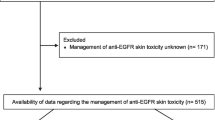Summary
Background Cetuximab is a chimeric monoclonal antibody targeting the epidermal growth factor receptor (EGFR). The recommended dosage is an initial load of 400 mg/m2 intravenously (IV) followed by a weekly maintenance dose of 250 mg/m2. It has been reported retrospectively that cetuximab efficacy was correlated with dose-related severity of skin rash. This study was prospectively designed to examine the safety and feasibility of escalating weekly doses of cetuximab, testing the hypothesis of the relationship of dose-dependent skin toxicity and efficacy. Methods Four dose levels were tested: Cetuximab 400 mg/m2 IV loading dose and 250, 300, 350, 400 mg/m2 weekly IV maintenance. There was no intra-patient dose escalation. Standard dose limiting toxicity criteria were used. Rash was evaluated using two additional validated dermatology methods: global acne grading scale (GAGS) and acne lesion counting (ALC). Tumor specimens and blood samples were obtained for correlative analyses. Results Twenty seven patients with solid tumors were enrolled: five head and neck, three pancreas, four gall bladder, two each of prostate, breast, colorectal, lung, and esophagus, and five others. Planned dose escalation was completed without reaching dose-limiting toxicity (DLT) or the maximum tolerated dose (MTD). The highest dose level was expanded to a total of 17 patients. Gr 3/4 toxicities included: lymphopenia (2), fatigue (2), and hypomagnesemia (2). One patient experienced a grade 3 rash (350 mg/m2). Sixty five percent of pts had a ≥ Gr 2 rash that was not dose dependent. In 22 evaluable patients, there was one partial response (PR) in a patient with cholangiocarcinoma (400 mg/m2) and seven patients had stable disease (SD). ALC and GAGS demonstrated no correlation with dose or response. Correlative studies evaluating k-ras, EGFR FISH status and immunologic correlatives were conducted on available tumor samples. Conclusions Cetuximab administered at 400 mg/m2 IV as a loading dose with weekly maintenance dose of 400 mg/m2 is feasible and well tolerated. There was no direct correlation of the grade of rash with dose in this group of patients with heterogenous solid tumors.

Similar content being viewed by others
References
Mendelsohn J, Baselga J (2003) Status of epidermal growth factor receptor antagonists in the biology and treatment of cancer. J Clin Oncol 21:2787–2799
Tos APD, Ellis I (2005) Assessing epidermal growth factor receptor expression in tumours: what is the value of current test methods? Eur J Cancer 41:1383–1392
Fan Z, Masui H, Altas I et al (1993) Blockade of epidermal growth factor receptor function by bivalent and monovalent fragments of 225 anti-epidermal growth factor receptor monoclonal antibodies. Cancer Res 53:4322–4328
Sato JD, Kawamoto T, Le AD et al (1983) Biological effects in vitro of monoclonal antibodies to human epidermal growth factor receptors. Mol Biol Med 1:511–529
Perez-Soler R, Saltz L (2005) Cutaneous adverse effects with HER1/EGFR-targeted agents: is there a silver lining? J Clin Oncol 23:5235–5246
Therasse P, Arbuck SG, Eisenhauer EA et al (2000) New guidelines to evaluate the response to treatment in solid tumors. European organization for research and treatment of cancer, national cancer institute of the United States, national cancer institute of Canada. J Natl Cancer Inst 92:205–216
Witkowski JA, Parish LC (1999) From other ghosts of the past: acne lesion counting. J Am Acad Dermatol 40:131
Lucky AW, Barber BL, Girman CJ et al (1996) A multirater validation study to assess the reliability of acne lesion counting. J Am Acad Dermatol 35:559–565
Doshi A, Zaheer A, Stiller MJ (1997) A comparison of current acne grading systems and proposal of a novel system. Int J Dermatol 36:416–418
Khan IH, Krishnan VV, Ziman M et al (2009) A comparison of multiplex suspension array large-panel kits for profiling cytokines and chemokines in rheumatoid arthritis patients. Cytometry B Clin Cytom 76:159–168
US Department of Health and Human Services: Common terminology criteria for adverse events (CTCAE) version 3.0. National Institutes of Health, National Cancer Institute, 2003
Jonker DJ, O’Callaghan CJ, Karapetis CS et al (2007) Cetuximab for the treatment of colorectal cancer. N Engl J Med 357:2040–2048
Koza I Sr, Wrba F, Vrbanec D et al (2009) Correlation of KRAS status with clinical outcome in patients (pts) with metastatic colorectal cancer (mCRC) treated first-line with FOLFOX6 + cetuximab (FX+C) or FOLFIRI + cetuximab (FF+C): The CECOG/CORE1.2.001 trial. ASCO Meeting Abstracts 27:4055
Burtness B, Goldwasser MA, Flood W et al (2005) Phase III randomized trial of cisplatin plus placebo compared with cisplatin plus cetuximab in Metastatic/Recurrent head and neck cancer: an eastern cooperative oncology group study. J Clin Oncol 23:8646–8654
Saltz L, Kies M, Abbruzzese L et al (2003) The presence and intensity of the cetuximab-induced acne-like rash predicts increased survival in studies across multiple malignancies. Proc Am Soc Clin Oncol 22:204
Author information
Authors and Affiliations
Corresponding author
Additional information
Sources of Support: Bristol-Myers Squibb.
Rights and permissions
About this article
Cite this article
Ho, C., Sangha, R., Beckett, L. et al. Escalating weekly doses of cetuximab and correlation with skin toxicity: A phase I study. Invest New Drugs 29, 680–687 (2011). https://doi.org/10.1007/s10637-010-9396-4
Received:
Accepted:
Published:
Issue Date:
DOI: https://doi.org/10.1007/s10637-010-9396-4




